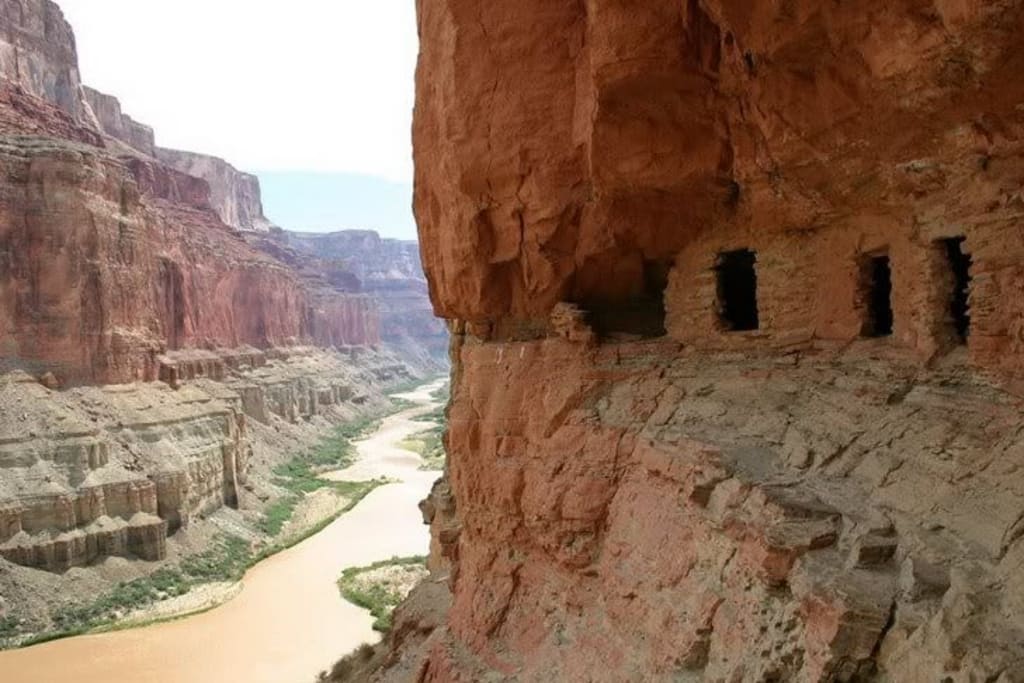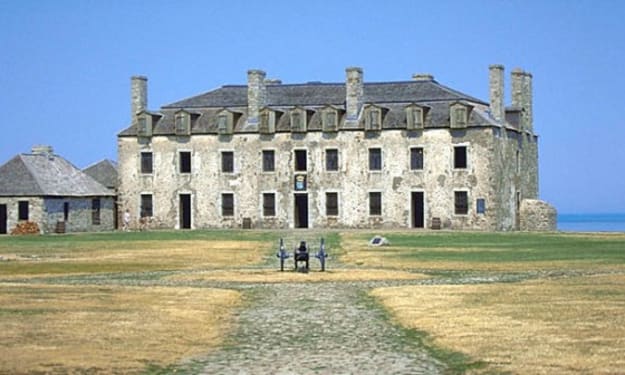Grand Canyon & Ancient Mythology
History of the Grand Canyon's First Inhabitants

Grand Canyon & Ancient Mythology
The Grand Canyon in Arizona has long been a source of beautiful mystery. The age of this stunning site has been a debate for about 140 years among scientists. It is estimated to be around 80 million years old, when the sea was last present there. As recently as 2012, studies of its age have broken down segments of it into five parts. Each segment was then analyzed to see how long ago each took to be carved. Only two segments, Marble Canyon and Western Grand Canyon, are less than 6 million years old. Hurricane Canyon is aged at approximately 70 million years, and the Eastern Grand Canyon is aged about 25 million years. The Colorado River first emerged from the Rocky Mountains about 11 million years ago, according to river sediment found. Where the river flowed before the Grand Canyon, and how exactly it began to flow there, are still mysteries among Geologists. They all agree that 6 million years ago, the Colorado River began carving its path through the segments, linking them together to form the Grand Canyon. Just that portion of its journey is 277 miles long. The Colorado River begins in the Rocky Mountains of Colorado, and it stretches 1,450 miles, to the Gulf of California. The Grand Canyon is so huge, there is a completely different weather condition at the top, than at the bottom. Canyon rock on the bottom has been dated to 1.8 billion years old.
After the gold rush in 1908, when President Theodore Roosevelt outlawed gold mining there, it was declared a National Monument. In 1919, acreage that calculated to a total of 1,217, 403 acres were declared The Grand Canyon National Forest by President Woodrow Wilson.
Although the Grand Canyon and Colorado River are considered Reservation lands, shared by the Navajo, Hopi, Havasupai, and the Hualapai Tribes who border it, the Federal Government has laid their laws down for tourists & civilians to abide by. Reservations may be Federal Property, but even they & any private companies, need to have Tribal permissions for any excavations or projects. It is also a ‘NO FLY ZONE.’
Were the Egyptians Ever There?
Geologists typically give names from ancient mythology to rock formations. There was a huge interest & ongoing trend involving Egypt in the early 1900s. All the attention was due to the many discoveries in Egypt during the period. This could explain the many Egyptian names of sites in, and around, the Grand Canyon. The tribes native to the area also gave names that still stick to area formations. Shinumo, meaning ‘Peace’ in Hopi, was given to Shinumo altar, Shinumo creek, and Shinumo wash, and Willaha meaning ‘Water hole’ in Havasupai are the perfect examples of misunderstanding the language of the names used for Grand Canyon sites. There are also Hindu names, like Shiva Temple, for some of the formations that stand there.
A cave named ‘Kincaid’s Cave’ sits about 1,400 feet down a steep wall of the canyon, and supposedly stretches for more than a mile within the earth. At the time of its ‘discovery’ by this missing Kincaid-man, who stated it's exploration by him came with the warning ‘no person shall be allowed within, under penalty of trespass,’ it is pretty obvious to me, from all that I have managed to read about it, that it's an absolute hoax. During the time period of 1869-1909, there wasn’t any security like there is today. Pretty much anyone could go anywhere in the mid-west, especially in the Grand Canyon. The only people were the Indians in that expanse terrain, and they pretty much kept to themselves. The Hopi Elders have a warning for those who go where they aren't supposed to, because 'the dead do not like to be disturbed'. That's the same rule for many cultures around the world. Except for maybe those who burn their dead, like the Hindu's, or the way Norsemen did, and care of the dead has also changed with each civilization, but I digress. So, these many artifacts, purportedly discovered there by a man named G. E. Kincaid, of the Smithsonian Institute were of Zuni, Egyptian, and Buddhism origins. Unfortunately, the Smithsonian has claimed to not have any record of Kincaid, sometimes spelled Kinkaid, or of his discoveries. Every researcher, even Natives who have inquired, said they have been told by the Smithsonian that his recovered artifacts were ‘thrown into the Ocean’, and that even though the news reports from 1909 stated his expedition was funded by them, he didn’t work for them. It is a high probability he worked FOR someone who was on the Smithsonian's payroll. Powell’s Cave was named after John Wesley Powell, who DID work for the Smithsonian at the time, and he DID explore the Grand Canyon. In his expedition, he brought along Frank Hamilton Cushing, who also worked for the Smithsonian.
A Zuni Elder tells of Asians that once lived there, and the estimated guess was they had come around 1100 A.D. The Taos pueblo, built between 1000 & 1450 A.D. is just to the north of Sante Fe. Is it possible the Taos people were mistaken for Asians? Even today they are a very secretive, private people. But so are the other nearby tribes, according to popular opinion. Since the Zuni pueblos, which date to the 10th Century, were built way before the Taos pueblos, I think that’s who the ‘Asians’ were. They have also said Welsh & Vikings came through the area, before 1492, and long before the Spanish Conquistadors came in the 1500’s, which is when the Indians started getting pushed around the Pueblo. After the tribes joined in an uprising against the Spanish, the Zuni returned from the cliffs, and carried on with their lives. They rebuilt their pueblo where it is today. Which is also where the Ancient Anasazi had been. Zuni’s give credit to Frank Hamilton Cushing for his sincere interest in Zuni culture. He was successful at gaining some of their land back for them from the American Government. The book “Zuni and the American Imagination” written in 2001 by Eliza McFeely, tell of his Anthropological adventures between his 1879 discovery of Zuni Pueblo life, five years of his life within the Zuni world, and his return to 1880's American civilization. He died not long after, in 1900, but was considered a radical for his efforts on behalf of the Zuni tribe.
Some folklore from The Arizona Gazette, and The New York Times, about the Grand Canyon is 'fact-backed' with old newspaper articles. The reporters who wrote these stories often went off hearsay, not actual research. They didn’t make physical investigations or visits to the sites in question. Just like the tale of "The Lost Dutchmen’s Gold" from 1891, in which a man told someone on his deathbed that he has gold hidden in a cave somewhere in Superstition Mountains. Then everyone with a case of gold fever, goes looking for it, having nothing more than a tall tale to guide them. There are many caves with this story attached. The earliest these stories date back to are the 1870s. Needless to say, just from the excerpts of his explorations that I found on the internet, I would conclude that any unexplored caves in 1909 would probably reek of guano (bat feces), be extremely dusty, and difficult to breathe in with the very poor ventilation. Without the strong artificial light like today, they would also be extremely difficult to navigate through. The Grand Canyon is not known for easy-to-reach ANYTHING. And he was alone? No wonder, after his initial reports, no one ever heard from this G. E. Kincaid again.
North American Mythology:
In the Hopi language, Sipapu, meaning small hole or indention, was the place where their ancestors first came to this world. They were changed from their lizard-like forms to become human beings. Sipapu Bridge, one of the largest natural formations in the world, which extends over the White Canyon, and Kachina Bridge, over Deer Canyon, are both natural formations in the Grand Canyon. It is considered a holy place to many tribes in the area.
Grand Gulch to Slickhorn Canyon, Utah, where the Anasazi (The Navajo translation for ‘Ancient Enemies’) also dwelled, have remains of their underground kavi’s that still exist today. Their dwellings were mysteriously abandoned in the 13th Century and are still being studied. Clifford Mahooty, a Zuni Elder, did in-depth studies on the mythology of Zuni & Atlantis/Lemuria connections to the area Tribes. He and other elders from area tribes very much believe that not only is there a river underground, but means for survival, according to the knowledge passed from generation to generation for thousands of years. That is what kept their ancestors alive until a time when they could survive above ground. Since then, it has been imperative for them to preserve their traditions, beliefs, and way of life to survive another change of human civilization. He clarifies the connection between the Zuni, (a bigger tribe than the Hopi) and the Ancient Egyptian are the same: They were shown from the star people their techniques & practices, to survive a world destroying event that changed the landscape, and the population of humans on Earth. Their preservation was a gift to ensure their way of life would not be lost and they could once again grow as a people. Likewise, the ‘Plumed Serpent’ of the Zuni, is the ‘Dragon’ of the Chinese. The Zuni also have the ‘Corn Mother’ as is the belief of other tribes. 'Spider-woman' was one of my favorites as well. She will draw all that is in her web, which spans across the universe in rainbows, back into herself. Then she will spin her web again. The Zuni consider the way humans are today, as the fixed version of what humans had turned into after thousands of years hidden underground in the caves of the Grand Canyon. ‘Raw People’ had to have their bodies fixed by the Kachina (spirits), who were friends to humans, as soon as they emerged. Tails removed, organs placed properly, extra fingers removed, etc. The drawings in the Grand Canyon is from those who were being ‘cooked’ so to speak. It was an immediate evolution by the Kachina. The ceremonies that took place to re-tell the story of the Kachina, always lasted days, not hours like today. Kachina depicted in the rituals and ceremonies, are the spirits that can be found in everything. There are over 400 Kachina.
Mass volcanoes, Earthquakes, and flooding are among the Zuni Prophecies of the end times, some of which have already happened. The sky will darken because the sun will not rise, the rain will be hot and burn, a low frequency, strange rumbling, with no known source, will start. The Taos hum that was discovered in the 1970’s, as well as the strange sounds documented around the world today are an example of the ancient Native prophecies. In 1962, a weapon known as the Electro-Magnetic Pulse (EMP) was tested by the U.S. Military over the Pacific Ocean. Launched from Johnson Island, 900 miles away from Hawaii, the missile detonated as expected, 240 miles above the Earth’s surface. The missile carried a 1.4 megaton warhead, and due to our in-expertise with such technology before 1962, the effects were not expected. Dubbed Operation Starfish, it was part of a larger exercise to study the effects of Nuclear explosions in space. It was strong enough to blow out all the streetlights, telephone, and radio frequencies on Hawaii’s electrical grid. Since then, no focus in this area of homeland security has been done, due to lack of imagination, and it has left us all helpless should such an event occur, whether it’s by our Sun or human antagonists. The one thing that all the Mayan prophecies and Elders of the Zuni and Hopi people have agreed upon through the ages is that man itself will be the cause of the world changing. The war between good vs. evil is told in many cultures throughout the world. For example, the second coming of Christ is a Christian prophecy that was related to the Rainbow Warriors of the many Indian tribes, including the Mayan. By making us all aware, so that we can prepare for that undergoing change, is all that they want to do.
*Check out my website! Sign-up & stay up to date on my e-books available on Barnes & Noble, Scribd, and iBooks!
References:
"Rainbow Warriors," Lakota County Times
Grand Canyon Statistics: NPS: Grand Canyon
Books: Over the Edge: Death in Grand Canyon
The Zuni Enigma: A Native American People's Possible Japanese Connection
About the Creator
Lady Sunday
I'm a self-publishing author of fiction and I love to research and write creative non-fiction.






Comments
There are no comments for this story
Be the first to respond and start the conversation.